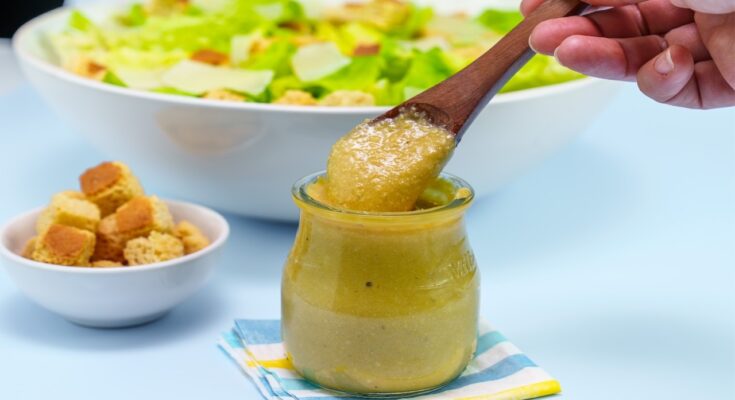Caesar Dressing Recipe: There’s something about the rich, tangy, and savory flavor of Caesar dressing that makes it a favorite in kitchens worldwide. Whether you’re enjoying it with a crisp Caesar salad, drizzling it over vegetables, or using it as a dipping sauce, this dressing packs a punch. And the best part? You can make it easily at home! This guide will walk you through a foolproof step-by-step process for the perfect Caesar dressing.
Why Make Caesar Dressing at Home?
Sure, store-bought Caesar dressing is convenient, but nothing beats the freshness and flavor of a homemade version. When you make it yourself, you control the ingredients and can customize it according to your taste. Plus, it’s free from preservatives, so it’s healthier and more delicious.
Ingredients for Caesar Dressing
Here’s a list of the essential ingredients that give Caesar dressing its signature flavor:
- Anchovies: Provide the umami boost.
- Garlic: Adds a punch of flavor.
- Egg yolks: Helps emulsify the dressing.
- Lemon juice: Brings freshness and acidity.
- Dijon mustard: Adds tang and helps with emulsification.
- Olive oil: Forms the base of the dressing.
- Parmesan cheese: Provides a rich, nutty flavor.
Traditional vs. Modern Variations
Anchovies or Worcestershire Sauce?
Traditional Caesar dressing uses mashed anchovies for an intense umami flavor, but some modern versions swap it with Worcestershire sauce for a milder taste.
Raw Egg or Mayo?
Using raw egg yolks is classic, but if you’re worried about safety, a spoonful of mayonnaise can act as a substitute for both the yolk and oil.
Kitchen Tools You’ll Need
- Whisk (for the classic method) or blender (for quicker mixing)
- Small mixing bowl
- Garlic press or fine grater
- Measuring spoons
Step-by-Step Caesar Dressing Recipe
Step 1: Preparing the Ingredients
Gather all the ingredients before starting. If you’re using raw eggs, ensure they’re fresh and refrigerated. Finely grate the Parmesan and mince the garlic.
Step 2: Mashing Garlic and Anchovies
In a bowl, mash 2-3 cloves of garlic with 3-4 anchovy fillets using the back of a spoon or mortar and pestle. This creates a smooth paste that will dissolve into the dressing without chunks.
Step 3: Adding the Mustard and Egg Yolks
Add 1 teaspoon of Dijon mustard and 2 egg yolks into the garlic-anchovy mixture. Whisk until well combined. The mustard acts as an emulsifier, helping the oil and other liquids blend smoothly.
Step 4: Slowly Drizzling in the Oil
This step is crucial! Slowly drizzle in ½ cup of olive oil while continuously whisking. Pouring too quickly can cause the dressing to separate. If you’re using a blender, add the oil in a slow stream.
Step 5: Mixing in Lemon Juice and Cheese
Once the oil is fully incorporated, add 2 tablespoons of fresh lemon juice and ½ cup of grated Parmesan cheese. Whisk until the dressing is smooth and thick. Taste and adjust seasoning with salt and pepper.
Tips for Perfect Caesar Dressing
Achieving the Right Emulsion
The key to a creamy Caesar dressing is emulsification – slowly adding oil while whisking helps bind the liquids together.
Adjusting Consistency
If the dressing feels too thick, add a bit of water or more lemon juice to thin it out. If it’s too runny, whisk in more Parmesan or oil.
How to Store Your Caesar Dressing
Refrigeration Guidelines
Transfer your Caesar dressing to an airtight container and refrigerate it. Homemade dressing is free from preservatives, so it’s best consumed within 3-4 days.
How Long Will It Last?
While refrigeration slows spoilage, this dressing doesn’t have a long shelf life. If you use raw eggs, consume it within 2 days. If you made a mayo-based version, it can last up to a week.
Uses Beyond Caesar Salad
This dressing is too delicious to limit to just salads! Here are some creative ways to use it:
Drizzling on Roasted Vegetables
Try it on roasted broccoli or Brussels sprouts for an extra savory touch.
Dipping Sauce for Finger Foods
Use it as a dip for veggies, chicken tenders, or even fries for a gourmet upgrade.
Nutritional Value of Caesar Dressing
A tablespoon of Caesar dressing typically contains around 80-100 calories, depending on the amount of oil and cheese. It’s high in fats (thanks to olive oil and Parmesan) but also offers some protein and calcium.
Common Mistakes to Avoid
- Adding oil too fast: This can break the emulsion, leaving you with a watery dressing.
- Skipping the anchovies: Anchovies add depth; even a little bit makes a difference.
- Using bottled lemon juice: Fresh lemon juice makes all the difference in flavor.
Customizing Your Caesar Dressing
Vegan-Friendly Alternatives
- Swap egg yolks with a tablespoon of tahini or plant-based mayo.
- Use capers instead of anchovies for a briny kick.
Adding Herbs and Spices
For a twist, add a pinch of smoked paprika or a handful of chopped parsley.
FAQs about Caesar Dressing Recipe
1. What are the basic ingredients needed for a Caesar dressing?
The classic Caesar dressing requires anchovies, garlic, Dijon mustard, lemon juice, olive oil, Parmesan cheese, and Worcestershire sauce. Some variations might include mayonnaise or sour cream for extra creaminess.
2. Can I make Caesar dressing without anchovies?
Yes, you can substitute anchovies with capers or omit them entirely if you prefer a vegetarian version. Keep in mind that anchovies add a distinct flavor, so adjustments may slightly alter the taste.
3. How long can homemade Caesar dressing be stored?
Homemade Caesar dressing can be stored in an airtight container in the refrigerator for up to a week. Always check for freshness before use.
4. Is Caesar dressing gluten-free?
Traditional Caesar dressing is gluten-free, but it’s important to check the labels on ingredients like Worcestershire sauce, as some brands may contain gluten. Always opt for certified gluten-free ingredients if you need to ensure it’s safe.
5. What is the best way to achieve a creamy texture in Caesar dressing?
For a creamy texture, blend the ingredients using a food processor or blender. Adding a small amount of mayonnaise or Greek yogurt can also enhance the creaminess of the dressing.
6. Can Caesar dressing be made vegan?
Absolutely! Replace Parmesan cheese with nutritional yeast or vegan Parmesan, and use plant-based alternatives for anchovies and Worcestershire sauce to create a vegan-friendly Caesar dressing.
Conclusion
Making Caesar dressing at home is simpler than you might think, and the result is a flavorful, creamy dressing that elevates any dish. With this guide, you now have everything you need to master the art of Caesar dressing. Give it a try – your salads will thank you!
References
For additional information and validation of the content provided in our Caesar Dressing Recipe with Post Links, consider exploring these reputable sources:
- Food Network – Provides a comprehensive guide on how to perfect classic Caesar dressing with tips from top chefs. Read the full article here.
- Epicurious – Offers a variety of Caesar dressing recipes including insights on ingredient variations and preparation techniques. Explore more at Epicurious.
- Serious Eats – Features in-depth culinary science behind making the iconic Caesar dressing, with step-by-step instructions for beginners. Learn more on Serious Eats.
- AllRecipes – Contains user-generated recipes and reviews, giving readers a broad perspective on how to tailor Caesar dressing to their tastes. View recipes on AllRecipes.
These sources are excellent for home cooks looking to expand their knowledge and refine their skills in creating classic Caesar dressing, ensuring delicious outcomes every time.



